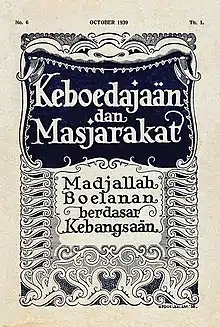Van Ophuijsen Spelling System
The Van Ophuijsen Spelling System was used as the orthography for the Indonesian language from 1901 to 1947. Before the Van Ophuijsen Spelling System was in force, the Malay language (and consequently Indonesian) in the Dutch East Indies (now Indonesia) did not have a standardized spelling, or was written in the Jawi script. In 1947, the Van Ophuijsen Spelling System was replaced by the Republican Spelling System.

History
Prof. Charles van Ophuijsen, who devised the orthography, was a Dutch linguist. A former inspector in a school at Bukittinggi, West Sumatra, he became a professor of the Malay language at Leiden University in the Netherlands. Together with two native assistants, Engku Nawawi and Mohammed Taib Sultan Ibrahim, he published the new orthography in Kitab Logat Malajoe: Woordenlijst voor Spelling der Maleische Taal in 1901, and published a second book, Maleische Spraakkunst, in 1910. The latter was translated by T.W. Kamil into Tata Bahasa Melayu in 1983 and became the primary guide for the spelling and usage of the Malay language in Indonesia.
Characteristics
The Van Ophuijsen Spelling System was modelled extensively on Dutch orthography, ostensibly to make pronunciation of Malay and Indonesian words more easily understandable to Dutch colonial authorities. Thus, Van Ophuijsen Spelling System used the Dutch variant of the Latin script, reflecting contemporaneous Dutch phonology. Some noticeable characteristics of this spelling system were:[1]
- The digraph dj was used to write [dʒ], for example djari.
- The digraph tj was used to write [tʃ], for example tjutji.
- The letter j was used to write [j], for example jang, pajah and sajang.
- The digraph nj was used to write [ɲ], for example njamuk.
- The digraph sj was used to write [ʃ], for example sjarat.
- The digraph ch was used to write [x], for example achir.
- The digraph oe was used to write [u], for example goeroe, itoe and oemoer.
- An apostrophe was used to write the glottal stop [ʔ], for example ma'moer, 'akal, ta' and pa'.
- A diaeresis, for example ä, ë, ï and ö, was used to indicate that a vowel was pronounced as a full syllable and not as a diphthong (ai [ai̯], au [au̯] and oi [oi̯]), for example dinamaï (pronounced as [dinamai], not [dinamai̯]).
- The letter é with an acute was used to write [ɛ], while plain e indicated [ə], for example énak vs. beli.
Limitations
While the van Ophuijsen system greatly aided Dutch speakers in pronouncing the Indonesian language, its complete reliance on Dutch orthography, which is rich in digraphs and trigraphs, often rendered unwieldy spellings of Indonesian words. For example:
- The digraph "oe" for [u] resulted in a conspicuous absence of the letter "u" in contemporary Indonesian texts, as "u" in Dutch orthography represents [ʏ] or [y] — sounds which do not exist in Indonesian. This produced awkward spellings, sometimes with three vowels occurring in a row, e.g. koeat and djaoeh; modern spelling kuat and jauh ("strong" and "far").
- The digraphs "dj" and "tj" for [dʒ] and [tʃ] were used to represent single sounds in Indonesian, and would eventually be simplified to "j" and "c" in modern Indonesian orthography. The digraphs "nj" and "sj" have been retained, albeit modernised to "ny" and "sy".
- The diaeresis was often redundant, especially when indicating glottal stops in between two identical consecutive vowels, e.g. kēboedajaän. The Dutch language regularly employs "aa", "ee" "oo" and "uu" to represent long vowels, and uses diaereses to signify separate sounds in vowel clusters, e.g. tweeëntwintig ("twenty-two"). However, there is no short/long vowel distinction in Indonesian. As such, it was not necessary to include a diaeresis in words such as kēboedajaän, kēbanggaän, kēënakan and so on; the doubled vowels already imply that they are voiced separately, without the need for a diaeresis.
The perceived shortcomings of the van Ophuijsen system led to the development of a partially revised orthography called the Republican Spelling System in 1947, and eventually to the adoption of the current Enhanced Indonesian Spelling System in 1972.
References
- S. Takdir Alisjahbana (1976). Language Planning for Modernization: The Case of Indonesian and Malaysian. The Hague: Mouton & Co. pp. 61–62. ISBN 9783110819106.
- Dari Ejaan van Ophuijsen Hingga EYD (in Indonesian)
- IPA for Indonesian Language
- Anton Moeliono, et al. (1997). Tata Bahasa Baku: Bahasa Indonesia. Balai Pustaka.